Much of the information in this report comes from the monthly emails I receive from John Bateman. He does public outreach for NOAA and in particular NCEI. I could find the same information and more on the NCEI website but John Bateman produces a good summary so I use it or most of it. I also usually add additional information from NCEI or other NOAA websites. The full NCEI report can be accessed HERE.
Arctic air mass brought bitter cold and snow to much of the nation in mid-January
Powerful storms brought heavy rainfall and flooding to parts of the southern PlainsContact
John Bateman, john.jones-bateman@noaa.gov, 202-424-0929February 8, 2024
Earth had another record-warm month
It was also the second-wettest January on record Contact
John Bateman, john.jones-bateman@noaa.gov, 202-424-0929February 14, 2024
|
|
|||

I start with the U.S. Key Points
The arctic air mass from January 14–18 broke nearly 2,500 daily minimum temperatures county records from the Northwest to the Lower Mississippi Valley.
On January 22–25, heavy rainfall brought more than a month’s worth of rain and life-threatening flooding to parts of Texas and Louisiana.
January 2024 was the 10th-wettest January on record for the nation, and temperature ranked in the middle third of the historical record for the month.
And then the Global Key Points
Temperatures were above average over much of the globe, but the eastern United States, most of Europe and a few other areas were cooler than average.
There is a 22% chance that 2024 will be the warmest year in NOAA’s 175-year record and a 79% chance that El Niño will transition to neutral conditions by mid-year.
Northern Hemisphere snow cover was near average, but Antarctic sea ice extent was fifth lowest on record for January.
Global precipitation was nearly record-high in January, following on the heels of a record-wet December.
I added the below to what John Bateman provided.
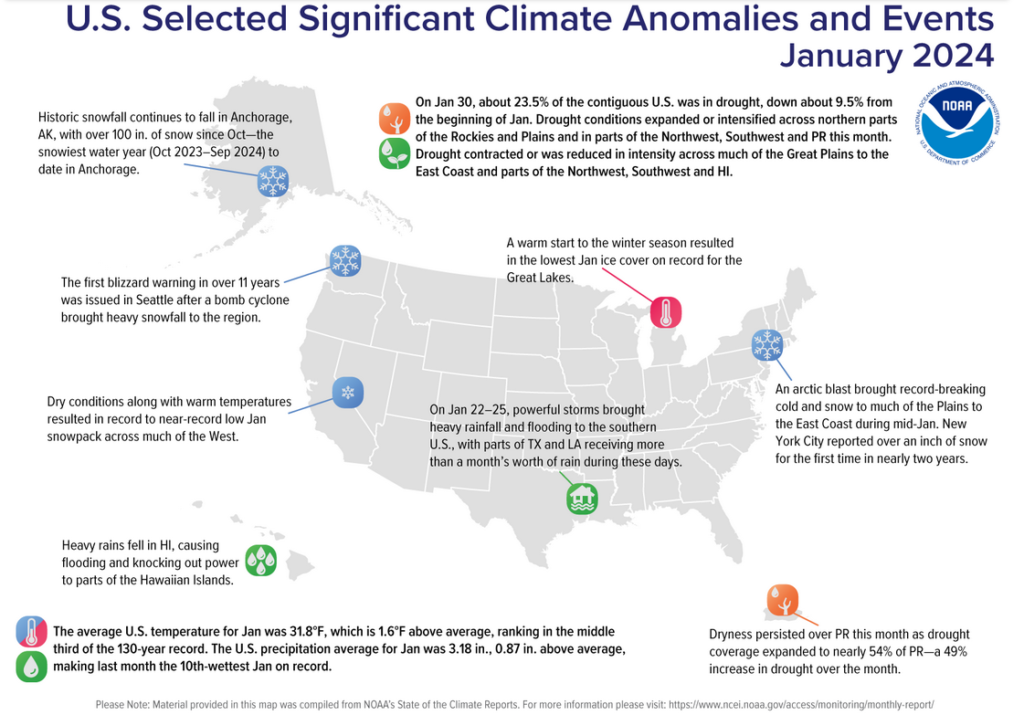
| January 2024 was a busy month |

–
| This is the temperature trend for CONUS. There was a decrease for January in 2024 |
–
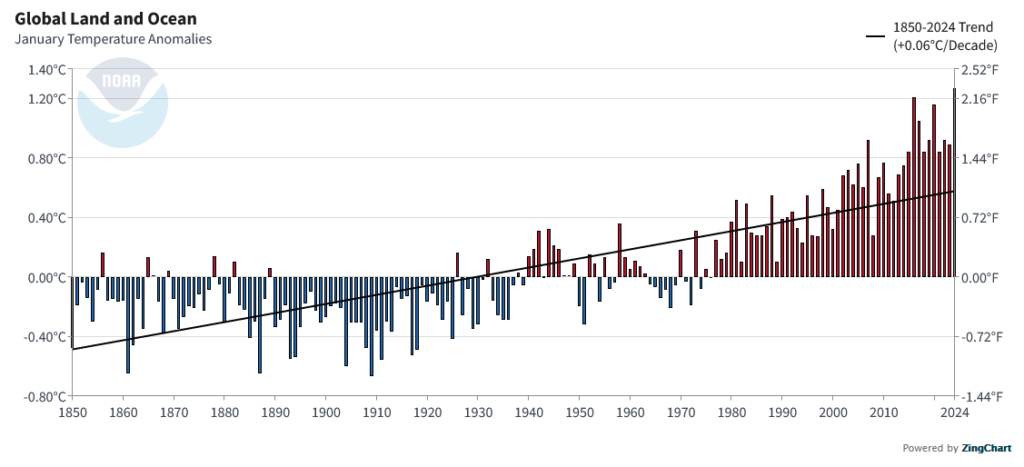
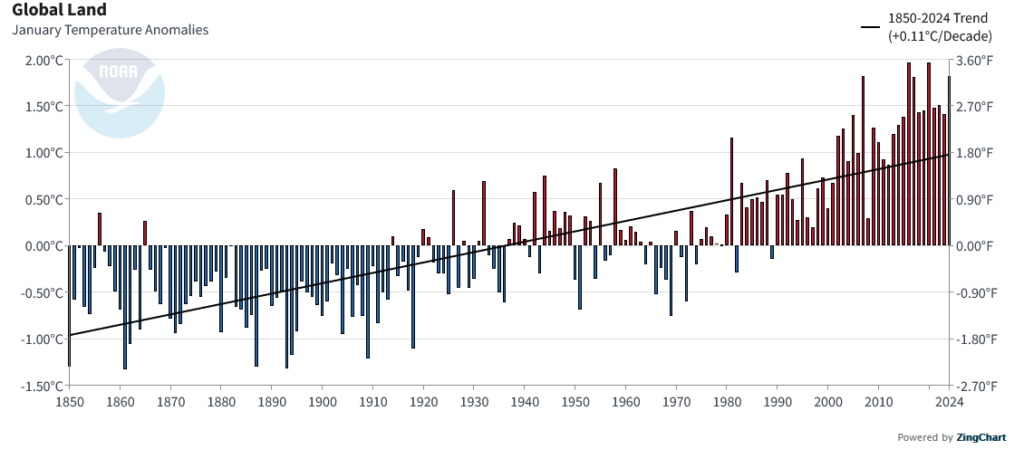
| The temperature for the world, land and water hit a new record, but when looking at land alone it was not a new record. |
To read the rest of this article some will have to click on “Read More”.
Now we present the rest of Bateman’s article for U.S Climate in January of 2024
Other Highlights:
Temperature
The average temperature of the contiguous U.S. in January was 31.8°F, 1.6°F above average, ranking in the middle third of the 130-year record. Generally, January temperatures were above average from the Carolina Coast to the Northeast and across parts of the West Coast, central Rockies, Upper Midwest and Great Lakes, with below-normal temperatures extending from parts of the Northwest to the Gulf of Mexico. Wisconsin had its 10th-warmest January on record.
The Alaska statewide January temperature was 2.9°F, 0.7°F above the long-term average, ranking in the middle third of the 100-year period of record for the state. Near-normal temperatures were observed across much of the state with above-normal temperatures observed in parts of the North, West and the Aleutians. Below-normal temperatures were observed in parts of the Interior and East.
Precipitation
January precipitation for the contiguous U.S. was 3.18 inches, 0.87 inch above average, ranking as the 10th-wettest January in the historical record. Precipitation was above average across much of the eastern U.S. and in parts of the West. Massachusetts and Connecticut ranked third wettest. Conversely, precipitation was below average from parts of the northern Rockies to portions of the Upper Midwest and in parts of the Southwest and coastal Carolinas. North Dakota had its 10th-driest January on record for this period.
Alaska’s average monthly precipitation ranked in the middle third of the historical record. Precipitation was below average across much of the state, while above-normal precipitation was observed in parts of the southeast Interior, Panhandle and the Aleutians during the month.
Other Notable Events
An arctic air mass brought record-breaking cold temperatures and snow to much of the contiguous U.S. during mid-January:
The mid-January arctic air mass dropped temperatures to 20 to 35°F below normal over parts of the northern and central Plains, while heavy snow fell over portions of the Great Lakes and the Northeast. The lowest temperature in the country occurred in Briggsdale, Colorado, with a low temperature of −35°F the morning of January 16.
Heavy snow fell over much of the Northeast, while New York City reported over an inch of snow for the first time in nearly two years on January 16.
Nashville received over six inches of snow on January 15—more than an entire winter’s worth of snow for the city.
A powerful bomb cyclone brought cold temperatures, strong winds and heavy snow to portions of the Northwest on January 8–10, resulting in the Seattle NWS issuing the first blizzard warning in over 11 years for the region.
Historic snowfall continued across portions of Alaska. Anchorage has received over 100 inches of snow since October—the snowiest water year (October 2023–September 2024) to date. In Juneau, the airport received more than 76 inches of snow in January, the highest January total on record and second highest monthly total.
Drought
According to the January 30 U.S. Drought Monitor report, about 23.5% of the contiguous U.S. was in drought, down about 9.5% from the beginning of January. Drought conditions expanded or intensified across northern parts of the Rockies and Plains and in parts of the Northwest, Southwest and Puerto Rico this month. Drought contracted or was reduced in intensity across much of the Great Plains to the East Coast, parts of the Northwest, Southwest and Hawaii.
This monthly summary from NOAA’s National Centers for Environmental Information is part of the suite of climate services NOAA provides to government, business, academia and the public to support informed decision-making. For more detailed climate information, check out our comprehensive January 2024 U.S. Climate Report scheduled for release on February 13, 2024. For additional information on the statistics provided here, visit the Climate at a Glance and National Maps webpages.
Here I add the State Rankings for January of 2024.
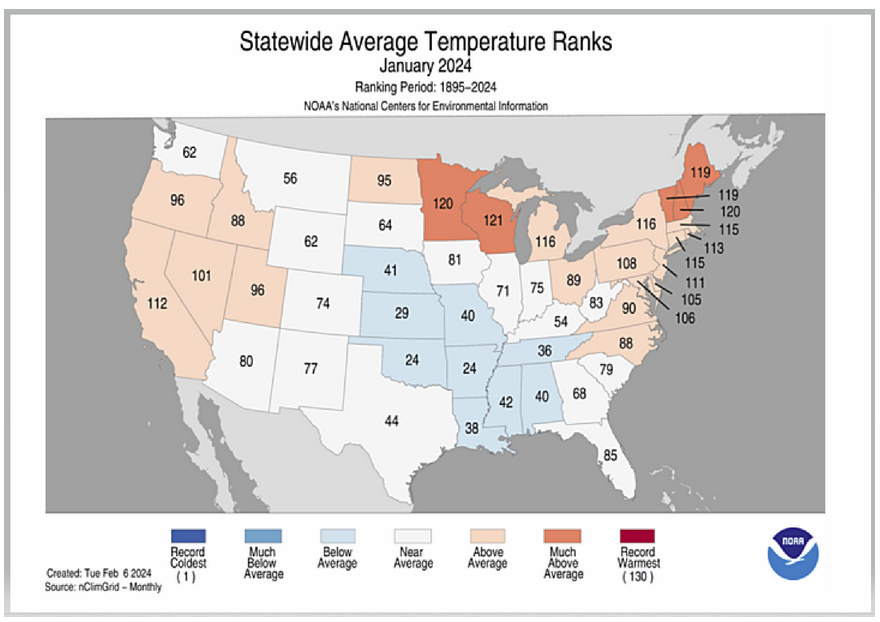
| Five states set records in January. |
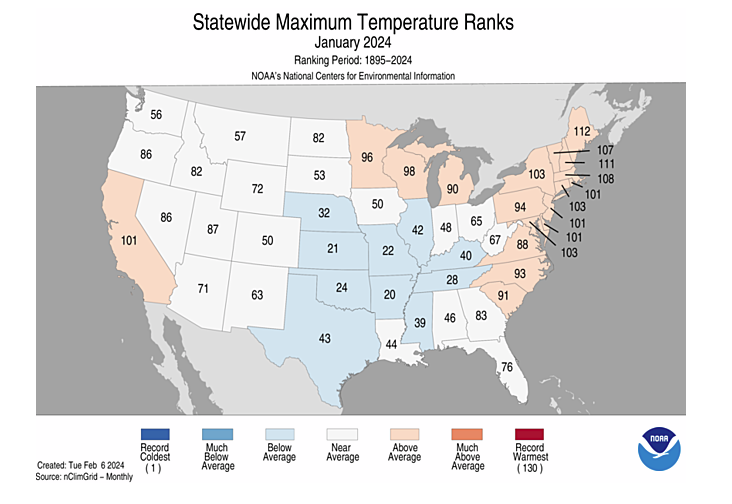
| Interesting that when looking at maximum temperatures no states set a record. |
![]()

| But when looking at minimum temperatures, 8 states set a record. |

| No records for precipitation by many states were much above average. |
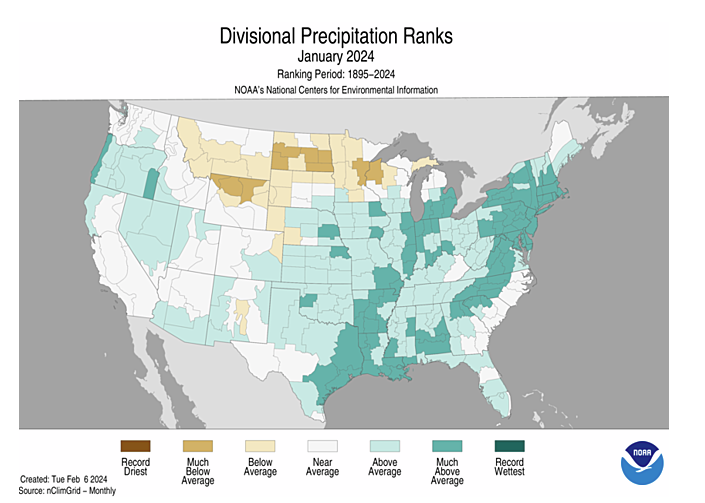
| Sometimes looking at climate divisions within states can be useful. The pattern is pretty interesting. |
Now we present the rest of Bateman’s article for Global Climate in January of 2024
|
|||
Useful Resources Include:
Climate at a Glance which can be accessed HERE
NCEI Monthly Report which can be accessed HERE
–
| I hope you found this article interesting and useful. |
–









